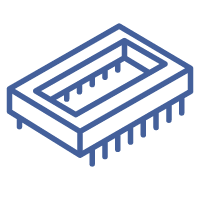
Analog Devices / Linear Technology LTM4613IV#PBF
LTM4613IV#PBF
LGA-133
23870668-LTM4613IV#PBF
- Mounting TypeSurface Mount
- Package / CaseLGA-133
- Surface Mount
having leads that are designed to be soldered on the side of a circuit board that the body of the component is mounted on.
YES - Supplier Device Package133-LGA (15x15)
- Number of Terminals133
- Maximum Output Current8A
- Dimensions15 x 15 x 4.42mm
- Package TypeLGA
- Maximum Operating Temperature
the maximum body temperature at which the thermistor is designed to operate for extended periods of time with acceptable stability of its electrical characteristics.
+125 °C - Minimum Operating Temperature-55 °C
- Switching RegulatorYes
- Maximum Input Voltage36 V
- Maximum Output Voltage15 V
- Moisture SensitiveYes
- Development KitDC1743A
- Unit Weight0.222226 oz
- Factory Pack QuantityFactory Pack Quantity119
- Mounting StylesSMD/SMT
- ManufacturerAnalog Devices Inc.
- BrandAnalog Devices
- Input Voltage-Max36 V
- Input Voltage-Min5 V
- TradenameuModule
- RoHSDetails
- SwitchingFrequency600 kHz
- PackageTray
- Base Product NumberLTM4613
- Voltage-Output 112V
- MfrAnalog Devices Inc.
- Product StatusActive
- Package DescriptionLGA, LGA133,12X12,50
- Package StyleGRID ARRAY
- Moisture Sensitivity Levels3
- Package Body MaterialUNSPECIFIED
- Package Equivalence CodeLGA133,12X12,50
- Manufacturer Package CodeLGA
- Operating Temperature-Min-40 °C
- Reflow Temperature-Max (s)30
- Operating Temperature-Max125 °C
- Rohs CodeYes
- Manufacturer Part NumberLTM4613IV#PBF
- Package CodeLGA
- Package ShapeSQUARE
- Part Life Cycle CodeTransferred
- Ihs ManufacturerLINEAR TECHNOLOGY CORP
- Output Voltage-Nom12.07 V
- Risk Rank3.68
- Part Package CodeLGA
- SeriesLTM4613
- Packaging
Semiconductor package is a carrier / shell used to contain and cover one or more semiconductor components or integrated circuits. The material of the shell can be metal, plastic, glass or ceramic.
Tray - Operating Temperature
The operating temperature is the range of ambient temperature within which a power supply, or any other electrical equipment, operate in. This ranges from a minimum operating temperature, to a peak or maximum operating temperature, outside which, the power supply may fail.
-40°C ~ 125°C - Size / Dimension0.59 L x 0.59 W x 0.17 H (15.0mm x 15.0mm x 4.3mm)
- JESD-609 Codee4
- ECCN CodeEAR99
- TypeDC/DC µModule Regulator
- Terminal FinishGold (Au)
- ApplicationsITE (Commercial)
- Additional Feature
Any Feature, including a modified Existing Feature, that is not an Existing Feature.
ALSO OPERATES IN ADJUSTABLE MODE FROM 3.3 TO 15V - HTS Code
HTS (Harmonized Tariff Schedule) codes are product classification codes between 8-1 digits. The first six digits are an HS code, and the countries of import assign the subsequent digits to provide additional classification. U.S. HTS codes are 1 digits and are administered by the U.S. International Trade Commission.
8542.39.00.01 - SubcategoryPMIC - Power Management ICs
- Terminal PositionBOTTOM
- Terminal Form
Occurring at or forming the end of a series, succession, or the like; closing; concluding.
NO LEAD - Peak Reflow Temperature (Cel)260
- Number of Functions1
- Terminal Pitch
The center distance from one pole to the next.
1.27 mm - Reach Compliance Codecompliant
- Pin Count
a count of all of the component leads (or pins)
133 - JESD-30 CodeS-XBGA-N133
- Number of Outputs1
- Qualification Status
An indicator of formal certification of qualifications.
Not Qualified - Approval Agency-
- Efficiency96%
- Voltage - Input (Max)36V
- Output Voltage3.3 V to 15 V
- Output TypeAdjustable
- Brand NameLinear Technology
- Voltage - Input (Min)5V
- Input Voltage-Nom24 V
- Temperature Grade
Temperature grades represent a tire's resistance to heat and its ability to dissipate heat when tested under controlled laboratory test conditions.
AUTOMOTIVE - Analog IC - Other TypeSWITCHING REGULATOR
- Operating Supply Current78 mA
- Current - Output (Max)8A
- Output Current
The rated output current is the maximum load current that a power supply can provide at a specified ambient temperature. A power supply can never provide more current that it's rated output current unless there is a fault, such as short circuit at the load.
8 A - Quiescent Current
The quiescent current is defined as the current level in the amplifier when it is producing an output of zero.
50 uA - Control Features-
- Voltage - Output 2-
- TopologyBuck
- Control ModeCURRENT-MODE
- Output Current-Max8 A
- Control TechniquePULSE WIDTH MODULATION
- Seated Height-Max4.42 mm
- Product Type
a group of products which fulfill a similar need for a market segment or market as a whole.
Switching Voltage Regulators - Voltage - Output 3-
- Switcher ConfigurationBUCK
- Switching Frequency-Max600 kHz
- Line Regulation
Line regulation is the ability of a power supply to maintain a constant output voltage despite changes to the input voltage, with the output current drawn from the power supply remaining constant.
0.3 % - Load Regulation
Load regulation is the capability to maintain a constant voltage (or current) level on the output channel of a power supply despite changes in the supply's load (such as a change in resistance value connected across the supply output).
0.75 % - Features-
- Input Voltage5 V to 36 V
- ShutdownShutdown
- Product Category
a particular group of related products.
Switching Voltage Regulators - Width15mm
- Height4.42mm
- Length15mm








